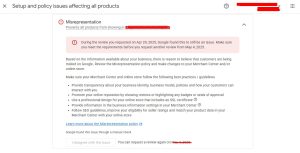Introduction to Google Merchant Center (GMC)
Google Merchant Center is an essential platform for e-commerce businesses. It allows them to list their products on Google, integrate with Google Ads, and show product ads on various Google properties. However, to ensure the smooth operation of your listings, businesses must comply with Google’s policies, one of the most critical being the Misrepresentation Policy.

What is a Misrepresentation Issue?
A misrepresentation occurs when Google detects that your product or website doesn’t match the information you provided in your Merchant Center feed. This can lead to the suspension of your account, making it impossible to advertise products through Google Ads and affecting your online visibility.
In this guide, we’ll break down the common causes of Google Merchant Center misrepresentation issues, why they occur, and most importantly, how you can fix them to ensure compliance.
Understanding Google Merchant Center Misrepresentation Policy
What is Google Merchant Center Misrepresentation?
Misrepresentation is any form of misleading information provided by merchants about their products, services, or business practices. Google Merchant Center’s Misrepresentation Policy is designed to protect users from deceptive, false, or harmful practices.
Examples of Misrepresentation Violations
-
Fake Products: If your products are not real, counterfeit, or unavailable.
-
False Claims: Claims like “best,” “guaranteed,” or “no.1” without substantiated proof.
-
Inaccurate Pricing: If the price shown in your feed is different from the actual price at checkout.
-
Misleading Product Availability: Listing products as “In stock” when they are actually out of stock.
Consequences of Violating the Policy
When you violate the misrepresentation policy, Google will:
-
Suspend your account.
-
Limit your ads from being shown.
-
Potentially blacklist your website from being advertised.
Common Causes of Misrepresentation Issues in Google Merchant Center
1. Inaccurate Product Information
Inaccurate product descriptions, images, or pricing information are often the primary reasons for suspension. Google uses automated systems to check if the information listed in your feed matches the product details on your website. If there’s a mismatch, your account could be flagged.
2. Pricing Mismatch
The prices in your feed must match those on the product landing pages. This includes tax, shipping, and any hidden fees. Google requires that users see the final price before checkout, and discrepancies here are a common cause of issues.
3. Misleading Product Availability
Google expects that the product availability status (in stock, out of stock, etc.) is accurately reflected. If you list an item as “In Stock” but it’s unavailable when a user tries to purchase it, that’s misleading.
4. Inconsistent Business Information
Your business details, such as name, address, phone number, and website, need to be clear, accurate, and consistent across your website and Google Merchant Center.
5. Website Problems
If your website is under construction, redirects users to a different website, or doesn’t load correctly, Google will flag it. A website with “thin content” or misleading claims will also cause a suspension.
6. Hidden Fees or Taxes
Google requires that all fees, taxes, and shipping costs are clear upfront. If users only find out about extra charges at the checkout page, it will lead to misrepresentation.
7. Suspicious Business Practices
If your business engages in suspicious billing practices, deceptive advertising, or selling restricted products (like counterfeit goods), Google will suspend your account.
How to Fix Google Merchant Center Misrepresentation Issues
Step 1: Audit Your Product Information
The first step is to conduct a thorough audit of your product listings. This includes checking:
-
Titles & Descriptions: Are they accurate? Are they misleading or overly vague?
-
Pricing: Ensure that the price on your website matches what’s in your feed, including taxes and shipping.
-
Product Availability: Regularly update your inventory status.
-
Images: Check that product images are clear, relevant, and real.
Step 2: Ensure Your Website Is Transparent and Fully Functional
Google wants to ensure that your business is legitimate, so:
-
Business Name and Address: These need to be visible on the website and match what’s provided in GMC.
-
Return, Refund, and Shipping Policies: Make these easily accessible.
-
Payment Methods: Provide a variety of trusted payment methods, like credit cards and PayPal.
-
Website Functionality: Your website must load properly without redirects or errors.
Step 3: Remove Misleading or False Claims
Google has a strict policy against making exaggerated claims, such as “best,” “most popular,” or “guaranteed.” All claims need to be backed by clear evidence. If you make such claims, they need to be truthful and substantiated.
Step 4: Update Your Merchant Center Feed Regularly
Ensure your feed is up-to-date with accurate information. Regular updates are essential to maintaining the accuracy of your listings. If you sell seasonal products or items that are frequently out of stock, this step is critical.
Step 5: Fix Any Tax or Shipping Mismatches
The prices shown in your Google Merchant Center feed must match the final price a user sees on your checkout page. Ensure taxes and shipping costs are properly set in both the feed and the website.
Step 6: Review Google’s Policies and Guidelines
Always keep Google’s Misrepresentation Policy in mind. It’s important to stay updated with any changes in Google’s rules and adapt your business practices accordingly.
Step 7: Submit a Request for Review
After making all necessary changes, go to your Merchant Center and submit a Request for Review. Google will manually assess your site and feed. This process may take several days.
Google Merchant Center Best Practices for Preventing Future Misrepresentation Issues
1. Regular Feed Updates
Ensure your product feed is updated regularly, at least every 30 days. Google requires real-time or near-real-time updates to reflect any changes in pricing or availability.
2. Accurate Tax and Shipping Information
From the outset, set up your shipping and tax rules in Google Merchant Center to match your website’s checkout process. Any discrepancies will cause Google to flag your account.
3. Monitor Product Listings
Constantly monitor your product listings for any signs of misrepresentation. Keep a close eye on your product data and any issues raised by Google in your Merchant Center account.
4. Use Trusted Tools for Feed Management
Use Google’s Product Feed Rules and third-party tools to automate feed updates. These tools can help reduce the likelihood of errors.
5. Be Transparent
Always be transparent about your business practices. If something is out of stock or unavailable, ensure that it’s accurately marked in your feed and on your website.
Conclusion
The Importance of Following Google’s Guidelines
Google Merchant Center is an essential tool for businesses wanting to advertise products online. However, it is crucial to follow Google’s policies and ensure that all information is accurate, transparent, and up-to-date.
Misrepresentation issues can significantly harm your business, but with a systematic approach, these issues can be easily resolved. By regularly auditing your product listings, ensuring your website is functional and transparent, and keeping up with Google’s guidelines, you can avoid misrepresentation issues and ensure your products are eligible to be shown on Google’s platforms.
If you have encountered a misrepresentation issue in Google Merchant Center, don’t panic. Follow this step-by-step guide to ensure that your business is compliant. Keep your account in good standing, and your ads will soon be visible again on Google.


